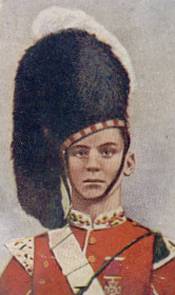Walter Potter Ritchie facts for kids
Quick facts for kids
Walter Potter Ritchie
|
|
|---|---|

Walter Potter Ritchie (depicted on a cigarette card)
|
|
| Born | 27 March 1892 Glasgow, Lanarkshire, Scotland |
| Died | 17 March 1965 (aged 72) Edinburgh, Midlothian, Scotland |
| Allegiance | |
| Service/ |
|
| Rank | Sergeant |
| Unit | The Seaforth Highlanders |
| Battles/wars | First World War |
| Awards | Victoria Cross Croix de Guerre |
Walter Potter Ritchie (born March 27, 1892 – died March 17, 1965) was a brave Scottish soldier. He received the Victoria Cross (VC), which is the highest award for bravery a soldier can get in the United Kingdom and Commonwealth countries. He earned this award for his amazing actions during the First World War, specifically at the Battle of the Somme.
Contents
Walter Ritchie's Early Life
Walter Potter Ritchie was born in Glasgow, Scotland, on March 27, 1892. He was one of six children. His father, also named Walter, worked with iron. Walter went to school in the Cowcaddens area of Glasgow.
After school, he started training to be a blacksmith. But soon, he decided to join the British Army. He joined the 8th Cameronians, even though he was a bit too young. Later, he moved to the 2nd Battalion of The Seaforth Highlanders and became a drummer.
Bravery in the First World War
When the First World War began, Walter Ritchie and his unit were sent to France. They were part of the British Expeditionary Force. He fought in the Battle of Mons in August 1914 and then in the First Battle of the Aisne the next month. In October 1914, he was hurt near Armentières.
The Battle of the Somme
On July 1, 1916, a huge battle called the Battle of the Somme began. Walter's unit was near a place called Mailly-Maillet. Their job was to capture land north of Beaumont Hamel.
The attack started with a lot of artillery fire. When the firing stopped, the soldiers moved forward. Walter's battalion was in the second group of attackers. But the enemy had many machine guns, and their fire was very heavy. Many officers were killed or wounded, and some British soldiers started to retreat.
A Bugle Call for Courage
Walter Ritchie saw what was happening. He did something incredibly brave. He climbed onto the edge of a trench, even though enemy machine guns were firing and bombs were exploding. He had his bugle with him, which he wasn't supposed to.
Against orders, he started playing his bugle. He played the "Charge" call over and over. This loud call helped to rally the British soldiers. It brought order back and stopped them from retreating. After the battle, only about 80 soldiers from his battalion were left.
Earning the Victoria Cross
For his amazing bravery on July 1, Walter Ritchie was put forward for the Victoria Cross (VC). The VC is the highest award for courage in the British Empire.
The official report about his actions said:
No. 68 Dmr. Walter Ritchie, Sea Highrs. For most conspicuous bravery and resource, when on his own initiative, he stood on the parapet of an enemy trench, and, under heavy machine-gun fire and bomb attacks, repeatedly sounded the "Charge" thereby rallying many men of various units who, having lost their leaders were wavering and beginning to retire. This action showed the highest type of courage and personal initiative. Throughout the day Drummer Ritchie carried messages over fire-swept ground, showing the greatest devotion to duty.
On November 25, 1916, King George V gave Walter his Victoria Cross at Buckingham Palace. Walter also received the French Croix de Guerre medal in December 1916.
He returned to fight on the Western Front. His battalion was involved in more battles, including those around Arras and the Battle of Passchendaele in 1917. They also fought in the Battle of the Lys and along the Hindenburg Line in 1918. By the end of the war, he had been wounded five times and gassed twice.
Walter Ritchie's Later Life
After the war, Walter Ritchie stayed in the British Army. He joined the 1st Battalion of the Seaforth Highlanders. He married Mary McLagan, and they had two children. He was promoted to sergeant and became the battalion's drum-major.
In 1921, he was part of the special guard for The Unknown Warrior at Westminster Abbey during the Armistice Day events. He left the army in 1929. After that, he worked as a recruitment officer in Glasgow, helping new people join the army. Later, he worked in education.
During the Second World War, Walter Ritchie rejoined the British Army. He served with the Royal Army Ordnance Corps in Britain until 1941, when he left due to his health. Walter Ritchie passed away on March 17, 1965, in Edinburgh.
Medals and Legacy
Besides the Victoria Cross and Croix de Guerre, Walter Ritchie received several other medals for his service in the First World War. These included the 1914 Star with Mons Clasp, the British War Medal, and the Victory Medal.
For his service in the Second World War, he received the 1939-45 Star and the War Medal 1939-45. He also had coronation medals for King George VI and Queen Elizabeth II, and the George V Silver Jubilee Medal. His medals are now owned by a collector in Australia.
The bugle that Walter used to rally his comrades during the Battle of the Somme is kept at the Queen's Own Highlanders Museum in Inverness. On July 1, 2016, exactly 100 years after his brave actions, a special paving stone was placed in his memory outside the People's Palace in Glasgow. Fifty members of his family were there for the ceremony.

